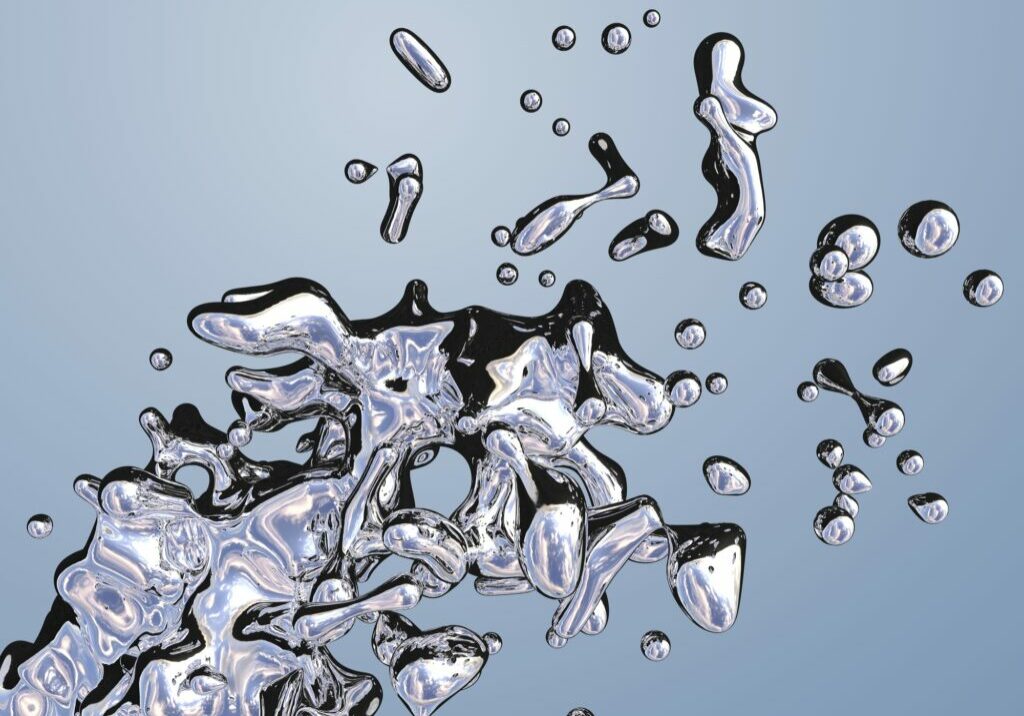Mercury spills in schools continue to cause dangerous exposures, school evacuations, and costly cleanups. Liquid mercury, also known as quicksilver, is a silvergray heavy metal that vaporizes at room temperature. As the only metal that is a liquid at room temperature, it is fascinating to all ages.
Historically, those unaware of the hazard had used it casually. Many remember being given mercury to hold in their palm. In many cases, mercury was spilled or washed down a drain during this kind of play at home or at school.
When exposed to the air, mercury metal vaporizes at room temperature where it may be breathed into the lungs. The warmer the temperature, the more quickly the mercury gets into the air. Mercury can also be absorbed through the skin.
If spilled mercury is not completely cleaned up, it spreads around on shoes, clothing, hair and other objects leaving behind tiny drops of mercury metal. Mercury can contaminate school buildings, grounds, vehicles, and homes. It can settle in cracks and porous surfaces like cloth, carpet, or wood, slowly emitting vapors over a long period of time. It is difficult and expensive to properly clean up spilled mercury.
Getting liquid mercury completely out of schools is the best spill prevention.
During 2002-07, mercury was the most commonly reported chemical released in U.S. schools. Almost 30 percent of incidents were reported by 15 participating states. There were 135 releases reported with 77 evacuations.
Two major causes of mercury spills at schools are improper storage and mishandling. The U.S. Environmental Protection Agency (EPA) encourages schools to prevent spills by removing all mercury compounds and mercury-containing equipment, and by discontinuing their use.
Where liquid mercury is found
Instruments containing mercury can be found virtually anywhere on school property – in the nurse’s office, science rooms, gymnasiums, art rooms, and boiler rooms. Liquid mercury is used in instruments that measure temperature (thermometers), pressure (manometers, barometers or sphygmomanometers), humidity (hygrometers), flow (water meters), and air speed (anemometers).
Mercury can also be found in light bulbs (particularly halide and fluorescent bulbs), thermostats, heating, ventilation and air conditioning (HVAC) systems, plumbing systems, cafeteria equipment, medical devices, regulators, gauges, and science room equipment.
Containers of liquid mercury might be found in science classrooms or storerooms. Mercury may still be used for demonstrations or simply stored for many years without being used. Sometimes children or adults bring mercury into schools as a novelty, for demonstrations, or as part of cultural rituals. Mercury-containing devices might be brought into the school by contractors, guest speakers, parents, staff, or students.
Eleven states, but not New Jersey, have enacted legislation that bans or requires reduced use of mercury in schools. For example, New York prohibits the use, purchase, and storage of mercury and mercury instruments in schools. Mercury instruments may continue to be used if no reasonably acceptable mercury-free alternative is available, as long as the mercury instrument used has the lowest mercury content available. The law directs the New York Commissioner of Health to compile, produce, and distribute material advising schools of the hazards of elemental mercury and how to reduce such hazards. These are available online.
Mercury health effects
Mercury is a substance that can produce a wide range of health effects to the brain, spinal cord, eyes, and kidneys, depending on the amount and timing of exposure. At high doses, mercury exposure can cause tremors, inability to walk, convulsions, and even death.
At levels more commonly seen in the U.S., mercury exposure effects include more subtle yet still serious damage to the senses and brain. Repeated exposures to low levels of mercury vapor over long periods have been associated with irritability, impulsiveness, drowsiness, impaired memory, and sleep disturbances. These effects may occur at lower levels of exposure in children than adults.
Local association action plan
- Work with your UniServ rep to form a union-management team to conduct an inventory of mercury sources in the district.
- Use the inventory form developed by the New York State Department of Health. The “Facility-Wide Inventory of Mercury and Mercury-Containing Devices” is available online. See the website listed under “Resources” on Page 2.
- Work with administration to use the results of the inventory to set priorities for proper disposal/recycling and replacement of mercury items most vulnerable to breaking or spilling.
- Where possible, mercury-containing devices should be replaced with mercury-free alternatives, such as electronic devices. The inventory form has specific suggestions.
- Work with your team to develop a comprehensive mercury spill response plan. Make sure school staff members know their role and whom to contact in the event of a spill. Even a few drops of mercury need to be cleaned up properly.
- Never use a vacuum cleaner, mop, or broom to clean up a mercury spill. These will spread the mercury, making proper cleanup more difficult and costly.
- Make sure mercury-containing products are well protected against breakage. Double-bag any item containing liquid mercury. Securely tape each plastic bag closed and place the item in a covered, unbreakable container such as a plastic bucket. Label the container “Mercury-Containing Devices” and store it in a locked cabinet or room until it can be properly disposed of or recycled.
- Districts should NOT throw items containing mercury in the trash. They must follow New Jersey Department of Environmental Protection (DEP) Universal Waste handling requirements. See the website listed under “Resources” on Page 2.
- Teach students in science class or in assembly about the importance of mercury safety using Mercury: An Educator’s Toolkit. See the website listed under “Resources” on Page 2.
- Report mercury spills to the DEP Hotline, 877-WARN-DEP (877-927-6336), and seek health advice from Poison Help, 800-222-1222.
